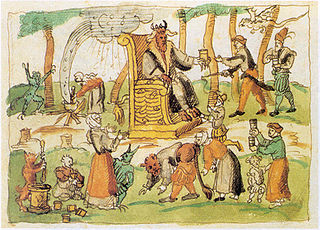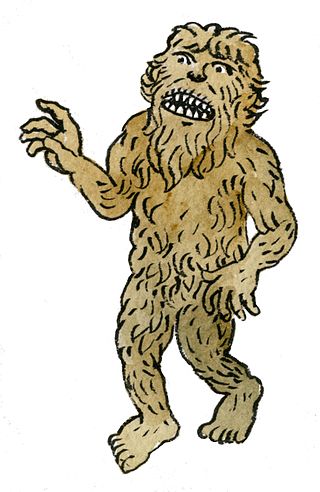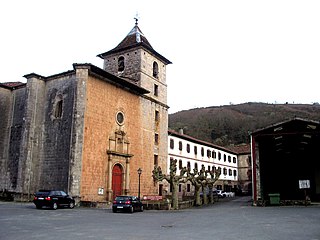
A Witches' Sabbath is a purported gathering of those believed to practice witchcraft and other rituals. The phrase became especially popular in the 20th century.

The mythology of the ancient Basques largely did not survive the arrival of Christianity in the Basque Country between the 4th and 12th century AD. Most of what is known about elements of this original belief system is based on the analysis of legends, the study of place names and scant historical references to pagan rituals practised by the Basques.

The jentil, are a race of giants in the Basque mythology. This word meaning gentile, from Latin gentilis, was used to refer to pre-Christian civilizations and in particular to the builders of megalithic monuments, to which the other Basque mythical legend the Mairuak are involved too.

Akelarre is the Basque term meaning Witches' Sabbath. Akerra means male goat in the Basque language. Witches' sabbaths were envisioned as presided over by a goat.

In Basque mythology, Sugaar is the male half of a pre-Christian Basque deity associated with storms and thunder. He is normally imagined as a dragon or serpent. Unlike his female consort, Mari, there are very few remaining legends about Sugaar. The basic purpose of his existence is to periodically join with Mari in the mountains to generate the storms.

Mari, also called Mari Urraca, Anbotoko Mari, and Murumendiko Dama, is the main goddess of the pre-Christian Basque mythology. She is married to the god Sugaar. Legends connect her to the weather: when she and Maju travel together hail will fall, her departures from her cave will be accompanied by storms or droughts, and which cave she lives in at different times will determine dry or wet weather: wet when she is in Anboto; dry when she is elsewhere. Other places where she is said to dwell include the chasm of Murumendi, the cave of Gurutzegorri (Ataun), Aizkorri and Aralar, although it is not always possible to be certain which Basque legends should be considered as the origin.

Urdazubi/Urdax is a village and municipality located in the autonomous community of Navarre, in the north of Spain.

Zugarramurdi is a town and municipality located in the province and autonomous community of Navarre in northern Spain. It passed into history as the setting of alleged occult activity featured in the infamous Basque witch trials held in Logroño in the seventeenth century. The town is home to the Basque witch museum and the Witch Caves. Every year, spectacular fires are lit in the caves near Zugarramurdi for the celebration of the ‘day of the witch’ on the summer solstice.
Pierre de Rosteguy de Lancre or Pierre de l'Ancre, Lord of De Lancre (1553–1631), was the French judge of Bordeaux who conducted the massive Labourd witch-hunt of 1609. In 1582 he was named judge in Bordeaux, and in 1608 King Henry IV commanded him to put an end to the practice of witchcraft in Labourd, in the French part of the Basque Country, where over four months he sentenced to death several dozen persons.

The Basque witch trials of the seventeenth century represent the last attempt at rooting out supposed witchcraft from Navarre by the Spanish Inquisition, after a series of episodes erupted during the sixteenth century following the end of military operations in the conquest of Iberian Navarre, until 1524.

Alonso de Salazar Frías has been given the epithet "The Witches’ Advocate" by historians, for his role in establishing the conviction, within the Spanish Inquisition, that accusations against supposed witches were more often rooted in dreams and fantasy than in reality, and the inquisitorial policy that witch accusations and confessions should only be given credence where there was firm, independent, corroborating evidence. He was probably the most influential figure in ensuring that those accused of witchcraft were generally not put to death in seventeenth- and eighteenth-century Spain. The Spanish Inquisition was one of the first institutions in Europe to rule against the death penalty for supposed witches. Its Instructions of 1614, which embodied Salazar's ideas, were influential throughout Catholic Europe.
The Labourd witch-hunt of 1609 took place in Labourd, French Basque Country, in 1609. The investigation was managed by Pierre de Lancre on the order of King Henry IV of France and III of Navarre. It resulted in the execution of 70 people.

Akerbeltz or Aker is a spirit in the folk mythology of the Basque people. It is said to live inside the land and is believed to have as many elves as servants. In Christianity, Akerbeltz is considered the live image of the devil, performing sexual abuses against Christians.
The Navarre witch trials took place in the Pyrenees in the Kingdom of Navarra in 1525-1526. It was a significant event in the treatment of witchcraft cases in Spain, as it led to a decision from the Spanish Inquisition in how to conduct witch trials.
María de Echachute, was one of the victims of the Basque witch trials, and one of six people executed by over hundreds of accused.
Petri de Joangorena was a Spanish alleged witch. He was one of the people charged with sorcery in the Basque witch trials (1609-1614), and one of only six people executed of 7,000 who were accused.
Domingo de Subildegui was a Spanish alleged witch. He was one of the people charged with sorcery in the Basque witch trials (1609–1614), and one of only six people executed of 7,000 who were accused.
Graciana Xarra was a Spanish alleged witch. She was one of the people charged with sorcery in the Basque witch trials (1609–1614), and one of only six of 7.000 accused to be executed.
Maria Baztan de Borda was a Spanish alleged witch. She was one of the people charged with sorcery in the Basque witch trials (1609-1614), and one of only six of 7.000 accused to be executed.
María de Ximildegui was a Spanish alleged witch. She was one of the people charged with sorcery in the Basque witch trials (1609-1614). She played an important role in the development of the Basque witch trials.








